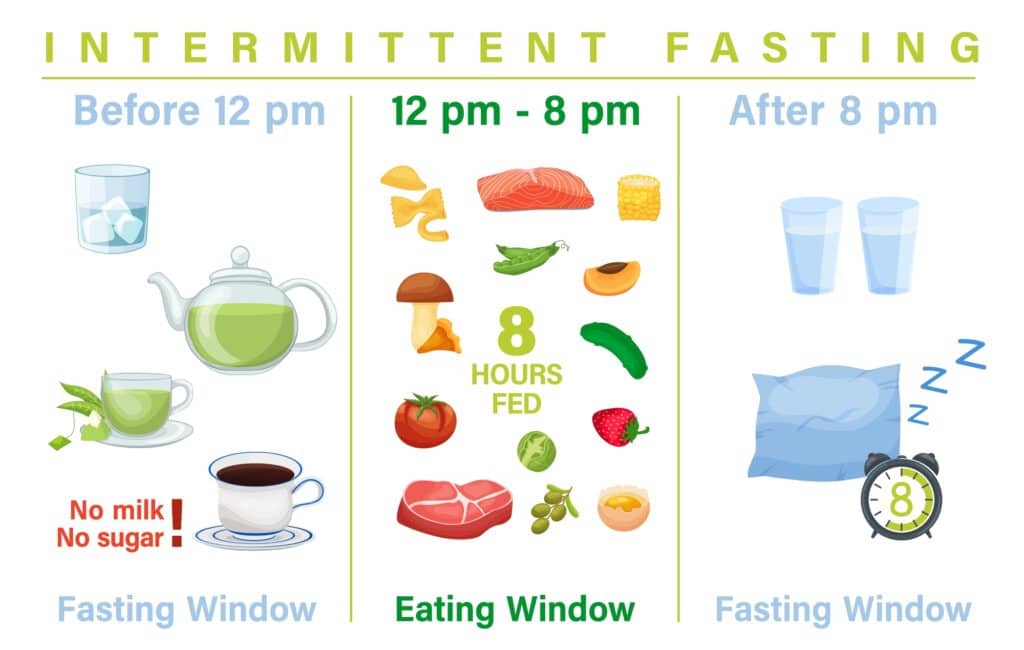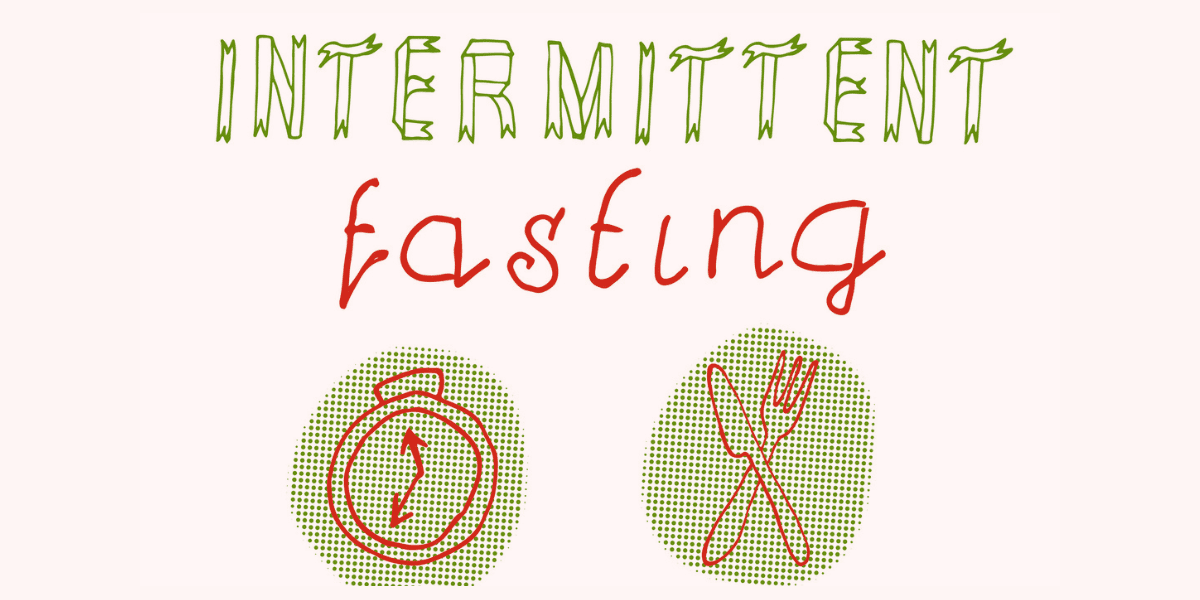EDITOR’S SUMMARY: There are many reasons you may be drawn to intermittent fasting (IF): detoxification, lowering blood sugar, balancing weight, or enhancing your energy level. Maybe you’re curious to find out what the current hype is all about. On the other hand, understandably, the thought of not eating for hours on end might provoke anxiety. Many of us, perhaps Americans in particular, have fallen into patterns of overconsumption of food. Eating large quantities multiple times a day, collectively we just don’t feel good. Intermittent fasting can simply give your organs a break by reducing inflammation and bloating, and interrupting the need for constant digestion from your “feeding window” being opened 24/7.
By Kathryn West
The topic of intermittent fasting (IF) is popular today, and has beckoned attention from mainstream to alternative communities. While good nutrition is essential to healthy living, intermittent fasting focuses primarily on when you eat and don’t eat—windows of feeding and refraining from eating—to achieve optimal health.
Simply put, intermittent fasting involves alternating eating and fasting periods based on a schedule to maximize your body’s potential to function efficiently.
The idea of abstaining from eating may seem counterintuitive, especially when you’re hungry. But if you consider your ancient ancestors, intermittent fasting was not a choice for much of humanity throughout history.
Early humans went days, sometimes weeks without food. Today, many people who are privileged with an abundance of food do not go more than four hours without eating during waking hours. Eating this frequently it turns out, may contribute to obesity, type 2 diabetes, heart disease, and other modern day illnesses.1
In general, there are seven popular fasting schedules:
ONE: 16:8 involves fasting for 16 hours, followed by an eating window of 8 hours. For instance, you may eat from noon to 8:00 pm, followed by a fasting period from 8:00 pm to noon the next day. For many, this schedule is easier and more sustainable than others, as many of your fasting hours occur during sleep.
TWO: 20:4 involves fasting for 20 hours, followed by an eating period of 4 hours. Also known as the “warrior diet,” this method is quite extreme. Some people allow small snacks during the 20-hour fasting time; others don’t eat anything. This schedule is similar to the OMAD (One Meal a Day) diet.
To obtain key benefits of fasting such as cell regeneration, longer fasting periods may be required, making the 20:4 fast more potent than shorter fasting periods. However, its advanced status makes it more difficult to implement. Prolonged periods of food deprivation can lead to dehydration and malnutrition. To help minimize the risks, combine this method with other fasting schedules.
THREE: 14:10 involves fasting for 14 hours, followed by an eating period of 10 hours. This is a simple way to ease into intermittent fasting. It’s also a good back-up plan if you follow the 16:8 schedule and miss the mark by a couple hours. You will still have fasted for 14 hours.
FOUR: 5:2 means eating normally 5 days a week, then reducing your normal caloric intake by 20 percent for the next two days. Also known as the “Fast Diet,” the 5:2 plan is readily adaptable, as your plan of eating stays the same 5 days a week. On your 2 fasting days, eat small meals of approximately 250 calories a few times a day, totaling 500–600 calories.
FIVE: 24-hour fast once or twice a week. If you don’t want to restrict your eating habits on a daily basis, a once a week 24-hour fast is an option you may want to consider.
SIX: 36-hour fast once a week. Due to the longer fasting duration, weight loss is likely to occur. If it’s your first time fasting, it might be a good idea to work your way up to this one, and allow yourself to be monitored by an experienced practitioner.
SEVEN: Alternate-day fasting, a.k.a. fast every other day. Some people eat very little (500 calories) on fasting days, which can be more sustainable than doing full-day fasts. This feast and famine approach doesn’t appear as popular as other intermittent fasting schedules.
You might associate intermittent fasting with weight loss, which is one of its notable benefits. This is because fasting allows your insulin levels to fall. According to Dr. Jason Fung, nephrologist and chief of medicine at Scarborough General Hospital, and one of the world’s leading experts on intermittent fasting:
Low insulin levels trigger the body to go from the feeding state where you’re storing calories, to the fasting state where you’re burning calories. If your body has excess sugar or body fat, it will consume the excess calories through fasting.
With less insulin being produced by eating, your body will begin to transition to fat burning as a source of energy. “Your body activates itself using energy from your own body, which is body fat… this is a huge advantage for weight loss,” says Dr. Fung. Essentially, you begin fueling yourself as your body seeks to use your stored body fat as energy.

Intermittent Fasting and Your Health
Studies have shown that intermittent fasting can help you live a longer and healthier life. In October 2017, Mark Mattson, neuroscientist at the National Institute on Aging and John Hopkins University School of Medicine, found that mice that had fasted regularly extended their lifespan, and experienced fewer chronic physical and mental illnesses common in old age, including type 2 diabetes, cardiovascular disease, cancers, and neurological disorders such as Alzheimer’s disease, Parkinson’s disease, and stroke.”
Medical science has established that cyclical intermittent fasting has the following benefits:
- Decreases blood sugar levels and insulin resistance
- Fights inflammation
- Enhances heart health
- Boosts brain function and prevents neurodegenerative diseases like Alzheimer’s and Parkinson’s
- Supports gut health
- Increases metabolism
- Weight loss
- May aid in cancer prevention
- Delays aging and extends longevity
According to an article published in Chiropractic Economics (January 2023), “How to build a strong and healthy immune system for patients in 7 steps,” intermittent fasting or “time-restricted eating” with a 14- to 16-hour fasting period, allowed patients’ immune systems to rejuvenate through autophagy and mitophagy.
Autophagy is a process in your body where the cells recycle themselves. This self-cleaning mechanism occurs when you stop eating for periods of time.
Damaged cells will literally eat themselves, allowing more room for new healthy cells to grow. Mitophagy is a similar process involving the mitochondria—the energy making factory of the cell.
The rejuvenation process reprograms the immune system, leading to improved immune balance and better immune resilience. Autophagy also plays a crucial role in gut health.
It maintains intestinal homeostasis and allows for the interaction between the gut microbiota and the innate and adaptive immune systems.
In addition, intermittent fasting helps maintain intestinal barrier integrity, which improves overall immunity. Some evidence indicates that people who fast intermittently experience fewer complications from COVID-19.”
NIH study, “Effects of intermittent fasting on liver physiology and metabolism in mice,” stated:
“It was concluded that daily 12 h of intermittent fasting for one month significantly reduced the liver weight of mice, which is associated with enhanced liver metabolism.”
IF is Not Necessarily for Everyone
While the established health benefits of intermittent fasting are abundant, from metabolic stability to promoting longevity, if you’re prone to particular health conditions, there may be drawbacks to consider.
If you are diabetic and take medication designed to lower blood sugar, the medication may need to be adjusted (consult with your healthcare practitioner) to coordinate with your fasting schedule.
Intermittent fasting might not be suitable for you if you regularly experience low blood sugar, low body fat, have an eating disorder, or are under a constant state of stress. In addition, converse with your doctor if you are instructed to take medications with food.
The health benefits of intermittent fasting have been well-substantiated by scientific studies. Detoxification is at work as well; from cell renewal to giving the liver, kidneys, and other organs a rest, thus allowing them to regenerate and function at their best.

Intermittent Fasting for Women in Particular
Women’s and men’s bodies are not the same; we can agree on that. Fasting affects women’s bodies, and specifically hormones, differently throughout the month. While it’s wise to listen to your body and pay attention to its cues, this is especially important during phases of your monthly cycle and menopause.
Research shows that women crave more carbohydrates during the luteal phase, which can help with estrogen production. Those sweet temptations can make IF harder to adhere to, so stay in tune with your body’s sensations, and consider taking a relaxed approach to intermittent fasting.
For example, ease up on the rules when you’re on vacation or out with friends, and avoid severe restrictions. If something feels off, then you may need to adjust your schedule. Pay attention to your appetite, and notice how your energy levels ebb and flow.
From a 2022 study, “New data on how intermittent fasting affects female hormones:”
“Intermittent fasting has been shown to be an effective way to lose weight, but critics have worried that the practice may have a negative impact on women’s reproductive hormones. Now, a team of University of Illinois Chicago researchers has published a study in Obesity that brings new evidence to the table.”
Dr. Eric Berg, author of “The Healthy Keto Plan” gives his input on women and intermittent fasting, which can be watched in this short video.
In addition to IFs impact on your hormones, if you keep a tight work and family schedule, you may find the following tips useful to stay grounded and on track:
- Stave off hunger with water or plain tea. Allow some time to pass and you’ll find that your hunger dissipates
- Stay hydrated with plenty of filtered water. Follow a nutritious diet that is low in sugar and refined carbohydrates
- Assess your lifestyle and decide what fasting schedule will best suit your needs
- Give yourself at least a month to get used to fasting
- Adhere to your fasting schedule; allow for flexibility
If intermittent fasting (IF) sounds intriguing to you, and you wish to give it a shot, taking a gradual approach as you’re learning the steps may be a smart way to ease yourself in.
Keep tabs on how you’re feeling—hunger levels, energy, focus/concentration, and mood changes. During difficult moments, remind yourself what you’d like to achieve by committing to this practice, and be willing to shift your pace.
The experience and results of “IF” are unique for everyone—from improving gut health, and lowering insulin and blood sugar, to feeling light as a feather. Above all, be gentle with yourself, enjoy the journey, and allow your intuition to guide you.
~
Published on March 16, 2023
If you’d like to contact A Voice For Choice Advocacy, please email media@avoiceforchoice.org.
If you would like to support the research and health education of AVFC editorial, consider making a donation today.

